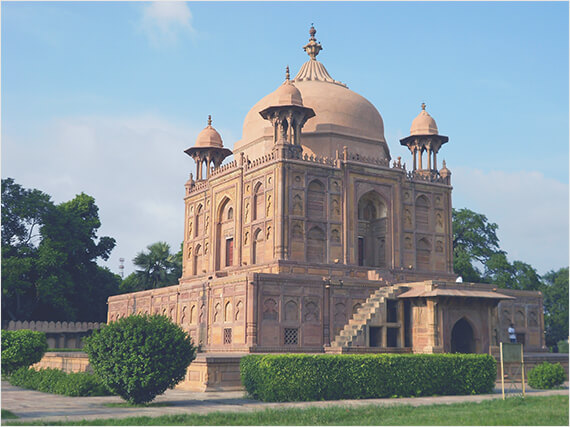Khusro Bagh
Khusro Bagh is a large walled garden, close to the Allahabad Junction Station, in
Allahabad, India, surrounding the tombs of Khusro Mirza (died 1622), eldest son
of emperor Jahangir, Shah Begum, Khusro's mother (died 1604), a Rajput princess
and Jahangir's first wife, and that of Princess Sultana Nithar Begam (died c.1624),
Khusro's sister.
 The three sandstone mausoleums within this walled garden, present an exquisite example
of Mughal architecture. The design of its main entrance, the surrounding gardens,
and the three-tier tomb of Sultana Begum, who died in 1604, has been attributed
to Aqa Reza, Jahangir’s principal court artist. Shah Begum, originally Man Bai,
was the daughter of Raja Bhagwan Das of Amber.
The three sandstone mausoleums within this walled garden, present an exquisite example
of Mughal architecture. The design of its main entrance, the surrounding gardens,
and the three-tier tomb of Sultana Begum, who died in 1604, has been attributed
to Aqa Reza, Jahangir’s principal court artist. Shah Begum, originally Man Bai,
was the daughter of Raja Bhagwan Das of Amber.
Distressed by the discord between her husband Jahangir and son Khusro, she committed
suicide in 1604 by swallowing opium. Her tomb was designed in 1606 by Aqa Reza and
is a three storied terrace plinth without a main mound, inviting comparisons with
Fatehpur Sikri by experts. The tomb however has a large chhatri that surmounts the
plinth and the arabesque inscriptions that adorn her tomb were carved out by Mir
Abdullah Mushkin Qalam, Jahangir's greatest calligrapher.
Next to the Begum's is the tomb of Khusro's sister, Nithar. Architecturally, this
is the most elaborate of the three. It lies on an elevated platform and is adorned
with panels depicting the scalloped arch motif. Within the plinth are rooms whose
ceilings have been elaborately painted with stars in concentric circles. The central
room has on its walls floral decorations depicting Persian cypresses, flowers and
plants.
The tomb of Khusro, is the last of the three tombs in Khusro Bagh. Khusro was first
imprisoned within the garden after he rebelled against his father, Jahangir, in
1606. Following an attempt to escape, he was blinded on Jahangir's instructions
and was later killed in 1622, on the orders of Khusro's brother and Jehangir's third
son Prince Khurram, who later became the Emperor Shah Jahan. The tomb has fretwork
windows and the tomb of his mare lies near his own.
Khusro's tomb was completed in 1622, while that of Nithar Begum's, which lies between
Shah Begum's and Khusro's tombs was built on her instructions in 1624-25. Nithar's
mausoleum is however empty and it does not contain her tomb within it.
During the Revolt of 1857 Khusro Bagh became the headquarters of the sepoys under
Maulvi Liyakat Ali who took charge as the Governor of liberated Allahabad. In Allahabad
however the Mutiny was swiftly put down and Khusro Bagh was retaken by the British
in two weeks.
The garden has now lend its name to the surrounding locality of Khusro bagh, which
is now a bustling township.